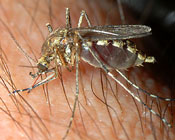Culiseta is found throughout the world. Most species are cold-adapted, meaning they occur mainly at elevations or during cooler parts of the year. Culiseta feed primarily on birds and mammals. A few feed on reptiles, and several species attack domestic animals and humans.
The larvae of most species are found in ground waters such as bogs, marshes, ponds, streams, ditches, and rock pools.

However, an African species occurs in tree holes (phytotelma); a common eastern Palearctic species occurs in water wells and rock pools; and several Australian species occur underground.
Culiseta incidens is a major nuisance species in the western U.S. Three species of Culiseta are vectors of both Eastern and Western Equine Encephalitis virus in North America:
Links to suggested control solutions
| VBC Biorational | Habitat |
| VectoBac 12AS VectoBac WG/WDG | Open habitats with minimal vegetation |
| VectoBac Granules VectoMax Granules | Open or vegetated habitats |
Quick Links
Contact a Valent BioSciences public health representative.
Contact Us